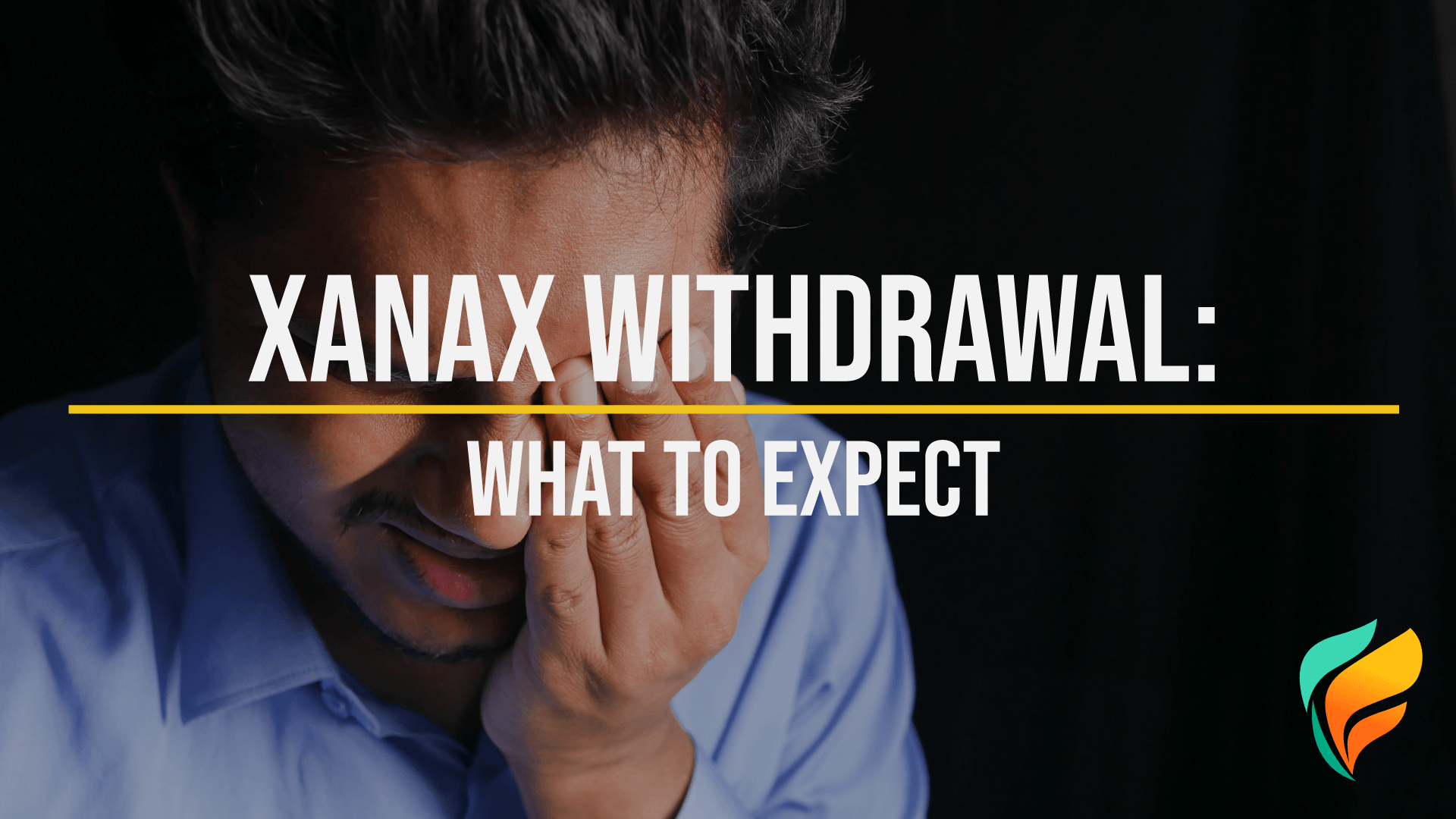Xanax Withdrawal: Symptoms, What to Expect & Treatment


Xanax withdrawal is hard. However, with the right help, it's easier, more comfortable, safer...and more likely to succeed. Learn more in our blog.
Xanax can produce a euphoric or calming effect, leading some individuals to misuse the medication by taking higher doses, using it more frequently, or using it recreationally. The pleasurable or anxiety-relieving effects can reinforce drug-seeking behaviors, contributing to the development of psychological addiction.
Addiction involves both physical and psychological components. Psychological addiction refers to the compulsive use of a substance despite adverse consequences.
Treating Xanax addiction involves a combination of behavioral therapies, counseling, and, in some cases, medication-assisted treatment. Gradual tapering of the drug under medical supervision helps manage withdrawal symptoms. In addition, therapy and counseling can address the underlying reasons for addiction, provide coping mechanisms, and support relapse prevention. In severe cases, inpatient or outpatient rehabilitation programs may be recommended.
However, one major step in treating Xanax addiction is navigating Xanax withdrawal. Withdrawal from benzodiazepines like Xanax is infamously difficult, but with the right help it’s easier, more comfortable, and safer.
Xanax Abuse Stats
Young adults were most likely to have used alprazolam or the chemically equivalent medication lorazepam for non-medical purposes, according to the 2013 National Survey on Medication Use and Health. Abuse was nearly twice as common among those 18 to 25 (10.3%) as among those 26 and older (5.7%).
How Does Xanax Cause Addiction?
Xanax is the brand name for the drug alprazolam, which belongs to a class of medications known as benzodiazepines. Benzodiazepines like Xanax are prescribed for the short-term management of various disorders such as anxiety and sleep disorders. While Xanax can effectively treat these conditions, it also carries a risk of addiction and dependence.
Xanax is addictive due to several factors:
How Xanax Works
Gamma-aminobutyric acid (GABA), a neurotransmitter, is enhanced by Xanax, which makes it more effective at affecting brain function. GABA is responsible for inhibiting the activity of nerve cells, which helps reduce anxiety and promotes relaxation.
Xanax binds to specific receptors in the brain, increasing the efficiency of GABA and producing a calming effect.
Tolerance to Xanax Develops Rapidly
With regular use, the brain can develop tolerance to the effects of Xanax. This means that over time, higher doses are required to achieve the same therapeutic effect. Tolerance occurs as the brain adjusts to the presence of Xanax and tries to maintain a balance in neurotransmitter activity.
Tolerance can lead individuals to take higher doses or use the medication more frequently, increasing the risk of addiction.
Physical Dependence on Xanax
Prolonged use of Xanax can lead to physical dependence, where the body becomes accustomed to the presence of the drug. When someone is physically dependent on Xanax, abruptly stopping or reducing the dosage can result in withdrawal symptoms.
These symptoms can be uncomfortable and may include anxiety, irritability, insomnia, tremors, sweating, and even seizures in severe cases. Physical dependence is not the same as addiction but can be a precursor to it.
Additional Risk Factors of Xanax
Several factors can increase the risk of Xanax addiction. These include a personal or family history of substance abuse, a history of mental health disorders, previous addiction to other substances, and environmental factors such as a lack of support systems or high-stress levels.
Additionally, using Xanax for an extended period, exceeding the prescribed dosage, or using it in combination with other substances (e.g., alcohol) can increase the likelihood of addiction.
What Are Xanax Withdrawal Symptoms?
When someone dependent on Xanax abruptly stops or significantly reduces their dosage, they may experience withdrawal symptoms. Xanax withdrawal can be uncomfortable and, in severe cases, potentially dangerous. Some of the common withdrawal symptoms associated with Xanax are:
Xanax Withdrawal: Rebound Anxiety and Panic
Xanax is often prescribed for the treatment of anxiety disorders, so when the medication is discontinued, rebound symptoms of anxiety and panic may occur. These symptoms can be more intense than they were before starting Xanax and can include restlessness, irritability, increased heart rate, heightened sense of worry, and feelings of impending doom.
Xanax Withdrawal: Insomnia and Sleep Disturbances
Xanax has sedative properties and can aid in sleep. During withdrawal, individuals may experience insomnia or disrupted sleep patterns. They may have difficulty falling asleep, wake up frequently throughout the night, or experience vivid dreams or nightmares.
Xanax Withdrawal: Gastrointestinal Symptoms
Xanax withdrawal can affect the digestive system, leading to gastrointestinal symptoms such as nausea, vomiting, stomach pain, and diarrhea. These symptoms can be distressing but are generally temporary and subside as the withdrawal progresses.
Xanax Withdrawal: Muscle Aches and Tension
Xanax withdrawal can cause muscle aches, stiffness, and tension. Some individuals may experience generalized muscle pain, while others may feel specific areas of tension, such as in the neck, shoulders, or back. These symptoms can contribute to feelings of discomfort and restlessness during withdrawal.
Xanax Withdrawal: Sensory Hypersensitivity
During Xanax withdrawal, individuals may become more sensitive to sensory stimuli. They may experience heightened sensitivity to light, sound, and touch. This increased sensitivity can lead to irritability, agitation, and an overall sense of being overwhelmed.
Xanax Withdrawal: Psychological Symptoms
Xanax withdrawal can also produce psychological symptoms, such as mood swings, irritability, depression, and difficulty concentrating. Some individuals may experience cognitive difficulties, including memory problems and difficulty with decision-making or problem-solving.
Xanax Withdrawal: Seizures
In rare cases, sudden discontinuation of Xanax, especially after long-term use or high doses, can lead to seizures. Seizures are considered a medical emergency and require immediate medical attention.
Are You Struggling with Mental Health or Addiction?
We Can Help. Call Us Now!
CALL: 877-839-1772
What Are the Factors that Can Affect Xanax Withdrawal?
Like other benzodiazepines, Xanax can be habit-forming, leading to dependence and potential withdrawal symptoms when discontinuing its use abruptly or rapidly tapering the dosage. Several factors can influence the severity and duration of Xanax withdrawal, including:
Duration of use: The length of time a person takes Xanax can affect withdrawal. Long-term users are more likely to experience more pronounced withdrawal symptoms than those who have used the medication for a shorter duration.
Dosage and frequency: Higher doses and more frequent use of Xanax can result in more significant withdrawal symptoms. People taking larger doses or using Xanax multiple times daily are more likely to have a more challenging withdrawal experience.
Individual physiology: People's body chemistry and genetic makeup can influence their response to Xanax withdrawal. Factors such as metabolism, liver function, and overall health can impact the speed at which the drug is eliminated from the system and how withdrawal symptoms manifest.
Tapering process: The method and rate of Xanax dosage reduction can significantly affect withdrawal symptoms. Gradual tapering under medical supervision is generally recommended to minimize the severity of withdrawal. Abrupt discontinuation or overly rapid tapering can lead to more intense and prolonged withdrawal symptoms.
Polydrug use: Concurrent use of other substances, especially central nervous system (CNS) depressants, such as alcohol or opioids, can complicate Xanax withdrawal. Multiple substances acting on the CNS can interact and magnify withdrawal symptoms, making the process more challenging.
Psychological factors: Mental health conditions, such as anxiety disorders or depression, can influence the experience of Xanax withdrawal. Individuals with pre-existing mental health issues may have heightened anxiety or mood symptoms during withdrawal.
Treatment of Xanax Withdrawal Symptoms
The treatment of Xanax withdrawal symptoms involves a combination of medical supervision, psychological support, and symptom management. The following are some approaches commonly used in the treatment of Xanax withdrawal symptoms:
Medical Supervision
Withdrawal from Xanax should ideally be made under the guidance of a healthcare professional who can monitor the process, provide appropriate tapering schedules, and intervene if severe symptoms arise. They may adjust the tapering schedule based on the individual's response and overall health.
Medications
In some cases, medication may be prescribed to assist with managing withdrawal symptoms. For instance, a longer-acting benzodiazepine, such as diazepam (Valium), may be substituted for Xanax during tapering due to its longer half-life, which can help smoothen the withdrawal process.
Other medications may be used to address specific symptoms, such as sleep aids for insomnia or anti-nausea medications.
Psychological Support
Therapy, such as cognitive-behavioral therapy (CBT), can help individuals develop coping strategies, manage anxiety, and address any underlying psychological factors contributing to their benzodiazepine use.
Lifestyle Adjustments
Making lifestyle changes that support overall well-being can aid in managing withdrawal symptoms. This may include regular exercise, practicing relaxation techniques (e.g., deep breathing, meditation), maintaining a healthy diet, and getting sufficient sleep.
Support Groups
Joining support groups or attending counseling sessions with others who have gone through or are going through benzodiazepine withdrawal can provide valuable emotional support and shared experiences. These groups can be found through an addiction center or community organizations.
Are You Struggling with Mental Health or Addiction?
We Can Help. Call Us Now!
CALL: 877-839-1772
What Does Xanax Rebound Anxiety Mean?
Xanax rebound anxiety refers to the phenomenon where the symptoms or condition that Xanax was initially prescribed to treat return or worsen after the medication is discontinued or the dosage is significantly reduced. It is a rebound effect that occurs as the body adjusts to the absence of Xanax and tries to regain its equilibrium.
When Xanax is abruptly discontinued, or the dosage is reduced, the abrupt decrease in GABAergic activity can lead to a rebound effect.
The rebound anxiety effect in the context of Xanax primarily refers to the return or worsening of anxiety symptoms. Since Xanax is commonly prescribed for anxiety disorders and panic attacks, the sudden removal of the medication can increase anxiety levels. As a result, the rebound anxiety may be more intense than the initial symptoms that led to the prescription of Xanax.
To minimize the rebound effect and manage to stop Xanax use, healthcare professionals often recommend a gradual tapering schedule. This allows the body to adjust gradually to the reduction in dosage, minimizing the severity of rebound symptoms.
If rebound symptoms become overwhelming or unmanageable, it is essential to seek medical guidance. A healthcare professional can provide additional support, recommend alternative treatment options, or adjust the tapering schedule if necessary.
How to Cope with Xanax Withdrawal Symptoms
Coping with Xanax withdrawal symptoms can be challenging, but some strategies and approaches can help manage and alleviate the discomfort. Here are some suggestions for coping with Xanax withdrawal symptoms:
Medical Supervision
Work closely with a healthcare professional experienced in Xanax withdrawal to ensure proper monitoring, guidance, and adjustment of the tapering schedule if needed. They can provide support, assess the severity of symptoms, and make recommendations for symptom management.
Gradual Tapering
Follow a gradual tapering schedule recommended by your healthcare professional. Slowly reducing the dosage of Xanax over weeks or months can help minimize the intensity and duration of withdrawal symptoms. Stopping Xanax with medical advisory is not recommended due to the risk of severe withdrawal symptoms.
Seek Support
Reach out to friends, family, or support groups for emotional support and understanding during withdrawal. Sharing your experiences and concerns with others who have gone through or are going through similar situations can be comforting and helpful.
Engage in Relaxation Techniques
Practice relaxation techniques such as deep breathing exercises, progressive muscle relaxation, meditation, or yoga. These techniques can help reduce anxiety, promote relaxation, and alleviate physical tension associated with withdrawal symptoms.
Maintain a Healthy Lifestyle
Take care of your physical and mental well-being by adopting healthy habits. This includes eating a balanced diet, engaging in regular physical exercise (with guidance from your healthcare professional), getting sufficient sleep, and avoiding substances such as caffeine and alcohol that can worsen withdrawal symptoms.
Practice Self-Care
Engage in activities that can distract you from the discomfort of withdrawal symptoms. Find hobbies, read books, watch movies, or listen to music to occupy your mind. Practice self-care activities that bring you comfort and relaxation, such as taking warm baths, practicing mindfulness, or spending time in nature.
Follow a Routine
Daily routines can provide structure and stability during withdrawal. Plan your day with regular activities and stick to a consistent sleep schedule. Having a routine can help manage anxiety and create a sense of stability.
Communicate with Your Healthcare Professional
If withdrawal symptoms become overwhelming or unmanageable, don't hesitate to communicate with your healthcare professional. They can provide guidance and reassurance and suggest additional strategies or medications to help alleviate symptoms.
Be Good to You
Remember that Xanax withdrawal is a challenging process, and it takes time for your body to adjust. Be patient with yourself and acknowledge that the symptoms will gradually improve over time. Practice self-compassion and be kind to yourself throughout the process.
Are You Struggling with Mental Health or Addiction?
We Can Help. Call Us Now!
CALL: 877-839-1772
Xanax Withdrawal Is Dangerous Alone. The Forge Recovery Center Will Help
Detoxing from Xanax should never be done alone, using the “cold turkey” approach, or with a detox kit. Xanax withdrawal is potentially dangerous – at best, detoxing alone from Xanax will be unsuccessful. At worse, it can be deadly due to seizures.
Fortunately, there’s a better way. The Forge Recovery Center offers evidence-based, effective treatment for Xanax addiction. We’ll help you through the Xanax withdrawal process safely and successfully. Afterward, we’ll help you address Xanax addiction at its roots, exploring the reasons that drive benzodiazepine addiction.
At The Forge, you’ll build the coping mechanisms and tools you need to create a happier, healthier life for yourself. Want to learn more about how Xanax withdrawal can be easier? Reach out to The Forge Recovery Center today.
Are You Struggling with Mental Health or Addiction?
We Can Help. Call Us Now!
CALL: 877-839-1772





